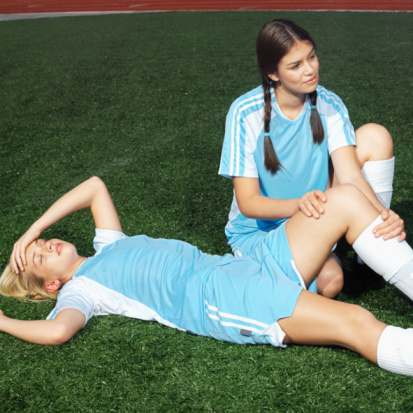Female athletes are at increased risk for injuries

The U.S. Women’s National Soccer Team captured the heart of fans across the country by winning the World Cup last week.
This victory may inspire young girls to spend countless hours on the soccer field with the goal of becoming the next Carli Lloyd or Alex Morgan, but experts say that too much training could leave them sidelined with injuries.
Female athletes are especially susceptible to overuse injuries. A recent study found that overuse injuries accounted for 13.3 percent of injuries occurring with girls playing high school sports, while they made up just 5.5 percent of injuries with high school boys.
“Overuse injuries are becoming more common as younger and younger children play a specific sport year round,” says Dr. Jeffrey Kazaglis, orthopedic surgeon at Advocate Sherman Hospital in Elgin, Ill. “When sports are rotated, different muscle groups are used and strengthened, preventing injuries due to repetitive stresses placed upon the growing bones and ligaments.”
Dr. Kazaglis says women are more prone to stress fractures than their male counterparts.
This may be due in part to the female athlete triad which is a combination of disordered eating, amenorrhea (abnormal periods) and premature osteoporosis. Premature osteoporosis puts athletes at risk for stress fractures, hip fractures and spinal fractures, according to a study published by the American Academy of Family Physicians.
“It is common with any sport to have some discomfort early in the season as you get in shape,” says Dr. Kazaglis. “As the season goes on, it’s not normal to have discomfort every time you play a sport. For example, if a softball pitcher has shoulder or elbow pain every time they throw, then something is wrong. If a volleyball player feels a ‘pinch’ in their shoulder every time they serve the ball, then it needs to be evaluated.”
Dr. Kazaglis offers these five tips to prevent overuse injuries:
- Warm-up before playing.
- Participate in conditioning such as jogging, sprints, push-ups, and core-exercises.
- Proper technique is also key. Coaches at all levels need to teach proper technique.
- Eat a well-balanced diet.
- Get eight hours of sleep each night. “I see many dog-tired high school athletes who get five to six hours of sleep a night. This doesn’t allow the body proper time to rest,” he says.
Related Posts
Comments
About the Author
health enews staff is a group of experienced writers from our Advocate Health Care and Aurora Health Care sites, which also includes freelance or intern writers.

















